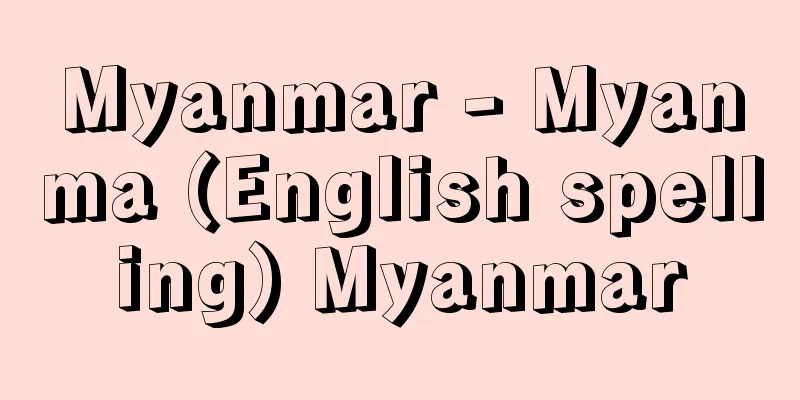Myanmar - Myanma (English spelling) Myanmar

|
A country located at the western edge of Southeast Asia. Its official name is the Republic of the Union of Myanmar. It was formerly known as the Union of Burma from independence in 1948 until 1974, and the Socialist Republic of the Union of Burma from 1974 to 1988. In 1988, the military government that seized power in a coup changed the country's name back to the Union of Burma, but the following year, in 1989, it changed its name to the Union of Myanmar, and at the same time, it renamed its capital, Rangoon, to Yangon. In October 2006, the capital was changed from Yangon to the central city of Nay Pyi Taw (Naypyidaw). In March 2011, a new government was formed, and the country's name was changed to the Republic of the Union of Myanmar. It borders Thailand, Laos, and China from the east to the north, India to the northwest, and Bangladesh to the west, and faces the Bay of Bengal to the southwest. Area: 676,578 square kilometres, population: 48,798,000 (2007 estimate). [Toshiaki Sakai] NatureThe trunk of the country is a long diamond shape, stretching 1,400 km north to south from 16 to 28 degrees north latitude, and 900 km east to west from 92 to 101 degrees east longitude. The long and narrow Tanintharyi (formerly Tenasserim) district stretches 800 km south from the southeastern edge, reaching 10 degrees north latitude. The overall outline of the country resembles a kite with its tail hanging down. The rough geological structure and topography are made up of three parts: the eastern mountain range, centered on the ancient Shan Plateau; the western mountain range, consisting of a series of Tertiary period folded mountain ranges forming an arc; and the central lowland lying between the two. The northernmost Kachin Mountains, which surround the source of the Irrawaddy (Ayeyarwady) River, are an eastern extension of the Great Himalayan Mountains, with a group of high mountains covered in perpetual snow and with glaciers rising above the tree line, including Mount Hkakabo Razi (5,885 meters), the highest peak in Southeast Asia, located at the northern end. Two mountain ranges, one east and one west, extend southward in a horseshoe shape from the Kachin Mountains. The Khao Lang Kung Range on the east side is the watershed between the Irrawaddy and Salween River basins, and forms the border with China. The Shan Plateau, which occupies the majority of the eastern mountain range, is part of China's Yunnan-Guizhou Plateau, and is a plateau at an altitude of 900 to 1,200 meters, consisting mainly of crystalline rocks and limestone. Mountain ridges reaching heights of 2,000 meters rise above the plateau, and the many river channels of the Salween River and its tributaries, including the Irrawaddy River tributary, carve narrow, ribbon-like lowlands into the plateau. The Western Mountains are made up of folded mountain ranges at around 2,000 meters above sea level, consisting of the Patkai Range, Naga Hills, Chin Hills, and Arakan Range from north to south. The tributaries of the Irrawaddy River and the rivers flowing into the Bay of Bengal carve complex valleys in a dendritic or lattice pattern. The southern end of the Arakan Range sinks into the sea at Cape Negres, but the Andaman and Nicobar Islands, which are part of Indian territory, are considered to be an extension of the Western Mountains. The central lowlands is a vast plain stretching approximately 1,100 km north to south and 200 km wide, where the Irrawaddy River and its first tributary, the Chindwin River, both flow gently and carry enormous volumes of water. At their mouths they form a delta 250 km long and 200 km deep, and the sediment discharged causes the coastline to advance several tens of meters each year. The Sittang River, which flows parallel to the east side across the Pegu Mountains, opens a large delta into the Gulf of Martaban. Meanwhile, the Salween River, which flows south through the center of the Shan Plateau, forms a delta with the Jain River and the Attaran River at its mouth into the Gulf of Martaban. The Tanintharyi region, which extends south, is generally mountainous and has narrow plains, due to the low mountain ranges behind it, such as the Dauna Mountains and the Birau Mountains, which form the watershed with the Chao Phraya River basin in Thailand. Off the coast of southern Tanintharyi, there are the Mergui Archipelago, with approximately 800 islands of various sizes arranged in three rows from north to south. On the Arakan Coast in the north, a plain spreads at the mouth of the Kaladan River and the Lemro River, which flow from the Chin Hills, but there is little other flat land, and islands such as Ramlay Island and Cheduba Island are located off the ria coast. Most of the country is located in the subtropics and faces the Bay of Bengal where the summer monsoons develop, so a typical tropical monsoon climate prevails. It is characterized by high temperatures that continue all year round and heavy rainfall concentrated in the summer. The northernmost mountainous area and the Shan Plateau have a temperate climate, with snow and frost in the winter. The midstream plain of the Irrawaddy River receives little rain because the Arakan Mountains block the summer monsoons, and the plain has a savannah-like landscape dotted with jungles of trees that can withstand dryness. In the coastal areas of Arakan and Tanintharyi districts, which are backed by mountains, the annual precipitation is close to 5,000 mm, 80% of which falls between June and September. In the Irrawaddy Delta, it is 2,000 to 2,500 mm, and in the Shan Plateau, far from the sea, it is about 1,200 mm. In the midstream basin of the Irrawaddy River, it is less than 800 mm, and in some places it is as little as 620 mm. Because of the high temperatures, areas with little precipitation are severely dry. The average annual temperature in Yangon, a city in the Irrawaddy Delta, is 27.4°C, with a maximum temperature of 30.9°C in April. The average annual precipitation is 2,261.7 mm, with the rainy season being from May to October. Hardwoods such as teak and pincado (Indian ironwood) that grow in the rainforests, which are deciduous during the dry season, are important sources of lumber, and there is a wide variety of bamboo that is used for a variety of purposes. Mangrove forests border the coastline in many places. There is a wide variety of wild animals, and elephants, tigers, leopards, yaks, deer, bears, wildcats, monkeys, and rhinos live in the forests far from human settlements. There are also a variety of birds, insects, and reptiles. Damage caused by poisonous snakes is constant, and the feared dung beetle and king cobra, which can reach a length of 170 centimeters, are highly venomous. [Toshiaki Sakai] GeographyGeographically, it is divided into three regions: the Eastern Mountains, the Central Lowlands, and the Western Mountains. Historically and culturally, the inland area centered on the midstream plain of the Irrawaddy River is called Upper Burma, while the Irrawaddy Delta and coastal areas are collectively called Lower Burma. Here, however, we will briefly describe the region by dividing it into the following nine regions. (1) Arakan Coast Region This long and narrow region facing the Bay of Bengal is separated from other regions by the Chin Hills and the Arakan Range. The annual rainfall is very heavy and concentrated in the summer, and the plains downstream of the Kaladan and Lemro rivers have been converted into rice fields. As the former home of the Arakan Kingdom, it has a different history from the Irrawaddy River basin and has had long relations with the Bengal region to the west. The Arakanese dialect is spoken here, and there are many Muslims. (2) Western Hill Region This mountainous region consists of the Chin Hills and the Arakan Range, and is covered with forests. It is divided into many districts by continuous mountain ranges and meandering river valleys. It is mainly inhabited by the Chin people, who practice shifting cultivation and rice cultivation in the valleys. (3) Northern Region The northern region is made up of highlands such as the Kachin Mountains and the Patkai Mountains, which are covered with subtropical and temperate forests, and the alluvial plains formed by the upper reaches of the Irrawaddy River and the Chindwin River. The lowlands are occupied by the Burmese and Shan peoples, who cultivate wet rice, while the mountainous region is home to the Kachin, Lisu, Naga and other peoples who live in semi-closed tribal societies. (4) Central Dry Region This region consists of the lowlands in the middle reaches of the Irrawaddy River. It is hot, and the humid seasonal winds are blocked by the mountains, so it is extremely dry in the summer. It has long been a rice-growing region based on reservoir irrigation, and is the homeland of traditional Burmese culture. There are many historical sites and Buddhist cultural heritage sites, such as Bagan, Aba, and Mandalay. There are deposits of crude oil and coal. (5) The Lower Irrawaddy Plain Region The humid virgin forests became the stage for agricultural development in the late 19th century, and were transformed into a rice-growing region for export. The Irrawaddy Delta is lined with rice paddies stretching for miles, and is connected by waterways. With the development of an immigrant and settled population and export trade, it has become an advanced economic region where a diverse range of ethnic and racial groups live together. There are many cities, including Yangon (Rangoon), Pathein (Bassein), and Prohm. (6) The Lower Sittang River Plain: Agriculture is thriving here, with rice and sugarcane as the main crops. There are the historic cities of Bago (formerly Pegu), Thaton, and Taungoo. (7) Pegu Mountains: A low mountain area covered with forests, inhabited by a small number of Burmese and Karen peoples, producing teak wood. (8) Shan Plateau Region The Shan people live in the river valleys and basins at an altitude of 600 to 800 meters, while the Karen, Wa and Palaung people live in the mountains where transportation is difficult. The region is known for rice cultivation, sericulture, tea, fruit cultivation, and cattle and buffalo raising. The region is rich in teak, bodwin and mauch minerals, and the Salween River system has great hydroelectric potential. (9) Tanintharyi (formerly Tenasserim) Region The mountains are close to the sea and there is little plain in general, but the Salween River Delta centered on Moulmein is a rice-growing area, and coconuts and rubber are also cultivated. Tin and tungsten are produced in various places. The northern plains are inhabited by a large number of Mon people, and the Moken people of the Mergui Archipelago are a semi-nomadic fishing people. [Toshiaki Sakai] historyThe period before the 10th century is not fully understood. In the first few centuries after Christ, the Austronesian Mon people settled in the area around the mouth of the Sittang River, and the Tibetan-Burman Pyu people settled in the area around the middle reaches of the Irrawaddy River. They developed a society based on wet rice cultivation and entered the stage of establishing small kingdoms. Indian cultures such as Brahmanism and Buddhism appear to have had a strong influence. The Burmese moved south from the interior of western China, advanced into the middle reaches of the Irrawaddy River, assimilated and absorbed the local Pyu people, and established their capital in Bagan in 849. During the reign of King Anawratha (reigned 1044-1077), they destroyed the Mon people of Lower Burma and established a national system. The successive kings of the Bagan dynasty had a deep respect for Buddhism and actively constructed temples and pagodas. After the Bagan Kingdom was attacked and weakened by the expeditionary forces of Kublai Khan of the Yuan dynasty (1287), a period of division continued with repeated conflicts between the Burmese, Shan, and Mon ethnic groups, but the Taungoo dynasty was established and expanded its territory in the mid-16th century, expanding its power. However, it was destroyed by the Mon people in 1752. In 1757, King Alaungpaya unified Upper and Lower Burma and established the last Burmese kingdom, the Konbaung Dynasty. Following the emergence of Portugal and France, the British, the rulers of India, sent troops to invade the Kingdom of Burma three times, destroyed it in 1885, and annexed it to India the following year, making it a colony. The Burmese anti-British independence movement began during World War I, and after the Great Depression, it spread among young intellectuals. Burma was occupied by the Japanese army during World War II, but various political forces united to form the Anti-Fascist People's Freedom League, which cooperated with the counterattacking British and Indian troops to repel the Japanese army. After the war, Burma signed an independence agreement with Britain, and became independent as the Union of Burma on January 4, 1948. Aung San, a key figure in the independence negotiations, was assassinated just before independence, and after independence, conflicts between political parties and ethnic groups intensified, and anti-government armed groups established themselves all over the country, plunging the country into civil war. Amid political and economic turmoil, Commander-in-Chief of the Army Ne Win seized power in a coup in March 1962. The constitution was suspended, the National Assembly was dissolved, and a Revolutionary Council was organized. Advocating Burmese-style socialism, Ne Win formed the Burma Socialist Programme Party, and adopted a policy of national isolationism politically and economically, promoting socialism centered on ensuring domestic security and nationalizing industry. However, the civil war continued, and the standard of living of the people remained low for a long period of time due to disruptions in distribution systems, stagnant agricultural and industrial production, and rising inflation. As the country finally began to stabilize, the Ne Win military regime gradually turned to return to the international community and gradually transitioned to civilian rule. In December 1973, a new draft constitution was overwhelmingly supported in a national referendum, and central and local elections were held in January and February 1974. A unicameral People's Assembly was established, and Ne Win became president. In November 1981, Ne Win retained only the position of party chairman, and was succeeded by San Yu (1918-1996). In September 1988, the military, led by Defense Minister General Saw Maung (1928-1997), seized power, established the State Law and Order Restoration Council (SLORC), and became its chairman. Anti-government forces remain within the country. [Toshiaki Sakai] PoliticsIn May 1990, a general election was held, and the National League for Democracy (NLD), led by Aung San's daughter Aung San Suu Kyi, who had been under house arrest by the government since July 1989, won an overwhelming victory, winning 392 of the 485 seats in the People's Assembly. However, the government refused to transition to civilian rule and continued to oppress democratic forces. In 1992, Chairman Soe resigned due to illness, and General Than Shwe (1933- ) became chairman and led the government as Prime Minister and Minister of Defense. The government ignored the will of the people and proceeded with preparations for the establishment of a new constitution, and the NLD became increasingly confrontational. In July 1995, the military government lifted Aung San Suu Kyi's house arrest, but dialogue between the government and the NLD did not take place. In 1996, large-scale anti-government student demonstrations took place in Yangon. In 1997, the State Law and Order Restoration Council was reorganized as the State Peace and Development Council (SPDC). In the same year, Than Shwe became chairman of the SPDC while retaining his positions as prime minister, minister of defence and commander-in-chief of the armed forces. Although he stepped down as prime minister in 2003 (while retaining his positions as minister of defence and commander-in-chief of the armed forces), he remained the de facto head of state. In September 2000, Aung San Suu Kyi was again placed under house arrest, but met with Than Shwe in January 2002 and was released from house arrest in May of the same year. However, in May 2003, military government authorities arrested Aung San Suu Kyi and other NLD leaders, and from September of the same year, she was placed under house arrest for the third time. In May 2004, the military government convened the National Assembly for the first time in about eight years, but the National Assembly had no legislative power and was in effect a military dictatorship. In November 2005, the Myanmar government announced that it would move the capital from Yangon to Pyinmana in the Mandalay Region. The move was completed around October 2006, and the new city was named Naypyidaw City. The local administration consists of seven regions (Sagaing, Mandalay, Tanintharyi, Magway, Yangon (Rangoon), Bago, and Irrawaddy (Ayeyarwady)) and seven ethnic autonomous regions (Kachin, Karen (Kain), Shan, Kayah, Mon, Rakhine, and Chin). In August 2007, anti-government demonstrations broke out following a large increase in the prices of gasoline and other fuels, spreading nationwide, primarily among Buddhist monks and ordinary citizens. By September, demonstrations involving 100,000 people took place in Yangon. The military government used force to suppress the protests, resulting in many deaths and injuries among demonstrators, and one Japanese journalist was killed while covering the protests. A report by the United Nations Special Rapporteur on Human Rights (December 2007) stated that the death toll was 31, with 74 people missing. In February 2008, the military government announced that a national referendum to approve the new constitution would be held in May of that year, and that a general election would be held in 2010. In the May 2008 national referendum, the new constitution was approved with 92.4% of the votes (according to the military government), but the referendum was forced through in a state of chaos after the devastating damage caused by a cyclone. The new constitution excluded Aung San Suu Kyi and maintained the power of the military, making one-quarter of the members of the Union Parliament military and stipulating that no one who, their parents, spouse, or children are foreign nationals or have foreign citizenship can become head of state. A general election was held in November 2010. In 2011, a new government led by President Thein Sein (1945- ) was inaugurated, and power was transferred from the State Peace and Development Council (SPDC). In April 2012, Aung San Suu Kyi, who had been released from house arrest, ran in the elections for the first time and was elected as a member of the lower house in the by-elections for both houses of parliament and local government councils. For a long time, Myanmar's foreign policy was based on non-alignment and neutrality, and it maintained a closed policy that was akin to isolationism, but the economy stagnated due to the continuing civil war and a lack of capital. Since 1990, it has adopted an open policy with the aim of becoming a market economy, and has actively sought to attract foreign capital. Myanmar sought membership in ASEAN (Association of Southeast Asian Nations), and although there was opposition within ASEAN, citing the military government's blatant suppression of democratic forces, the decision was made to join in May 1997, and the country officially joined in July of the same year. The national armed forces consist of 375,000 army members, 16,000 navies, and 15,000 air forces (2007), all of which are volunteer-based. [Toshiaki Sakai] economyDuring the colonial period, the development of forest and mineral resources, transportation, and trade in Burma were dominated by the British, while small and medium-sized commerce and distribution were dominated by the Chinese and Indians. The rice-growing areas of the Irrawaddy Delta were developed after the country became a British colony. As a result, there was a large influx of Indian seasonal laborers, and one-third of the farmland in Lower Burma was owned by Indian financiers and absentee British landlords known as the Chettiar caste. Burma was a typical example of a colonial economy, exporting rice, teak, oil, and metals and importing a variety of industrial products, including consumer goods. After independence, the country nationalized the main means of production and advocated the construction of a socialist economy, but the economy generally stagnated due to a lack of capital and human resources with management skills. In 1990, the country switched to a market economy policy, and the economy has since become more active. Myanmar showed a high economic growth rate from 1992 to 1995, but since then exchange rate problems and a rigid economic structure have hindered economic development, and there has been a noticeable shortage of foreign currency. Following the arrest of Aung San Suu Kyi in May 2003, the United States enacted new sanctions against Myanmar, which dealt a blow to the country. In October 2004, the European Union (EU) strengthened the sanctions it had imposed in response to Myanmar's anti-democratic situation (including a ban on loans to Myanmar's state-run enterprises). In September 2007, the military government used forceful measures against demonstrators, and the United States and the European Union further strengthened economic sanctions. Australia also imposed financial sanctions, and the country continues to face severe economic conditions. The currency in circulation is the Kyat. [Toshiaki Sakai] Agriculture, forestry and fisheriesIn 1953, land reform was carried out, and farmland in excess of ownership limits was expropriated and distributed to landless farmers. In 1979, 4.27 million farm households cultivated 9.6 million hectares of land, with 31% of farm households owning less than 2 hectares and 24% owning 2-4 hectares of land per household. At its peak before World War II, Indonesia was the world's number one exporter of rice, exporting 3 million tons per year, but export capacity has declined dramatically due to population growth, sluggish prices, and inadequate distribution systems. In 2005, the agricultural population was a high 70% of the total employed population. The cultivated land area was 10,068,000 hectares, of which 888,000 hectares was for fruit and other perennial crops, with paddy fields accounting for approximately 60% of the cultivated land area. Grain production in 2006 was 26,474,000 tons, of which 95%, or 25.2 million tons, was rice production. Besides rice, the main crops cultivated in Lower Burma are cotton, sugarcane, sesame, tea, and jute. In the dry Upper Burma, irrigation agriculture using canals and reservoirs is important, and after rice, cotton, tobacco, groundnuts, barnyard millet, sesame, beans, and corn are the most commonly cultivated crops. In the hilly areas of the Shan Plateau, various fruit trees and vegetables, tea, and coffee are produced. The forest area is 32.22 million hectares, accounting for 49% of the country's land area, of which 9.6 million hectares are managed forests. Forests that had been owned by foreign capital were nationalized in 1949, and the State Timber Agency has a monopoly on felling, transportation, sawing, and sales. The annual timber production (2006) was 42.548 million cubic meters, of which 4.262 million cubic meters was usable timber and the remaining 38.286 million cubic meters was firewood and charcoal. Teak, which is valuable for furniture, and hardwoods are also exported as lumber. Inland fishing, which uses nets and traps in rivers, lakes, canals, and rice paddies, has traditionally been thriving, but marine fishing now accounts for about 70% of the catch. The total fish catch in 2006 was 2,007,000 tons, of which 1,376,000 tons was from marine fisheries. Marine products are an essential part of the Burmese diet, as they are used to make salted and dried fish and fish sauce. [Toshiaki Sakai] Mining and ManufacturingCrude oil is extracted in the area around Enangyaung in the middle of the Irrawaddy River, and was an important export industry during the colonial period. However, Burma's status as an oil-producing country has declined drastically due to the heavy damage it suffered during World War II and the civil war, as well as the dramatic increase in oil production in West Asia and North Africa. In recent years, new oil fields have been developed in Chauk and Minbu, and production has increased along with natural gas. Offshore oil exploration is being carried out with technical cooperation from abroad in the Gulf of Martaban and off the Arakan coast. Offshore gas fields have also been discovered in the same area and in the Andaman Sea, and most of the natural gas produced is exported to Thailand. There are various mineral deposits, but they have not been fully developed. Lead and zinc are found in Bawdwin in the northern part of the Shan Plateau, and tin and tungsten are found in the southwest of the plateau and along the coast of Tanintharyi District. Mining and refining have been carried out by the Petroleum and Minerals Development Corporation since 1962. Rubies and sapphires, which have long been known, are mined in Mogaung in the western Shan Plateau, while jade is mined in Mogaung in southern Kachin State. During the colonial period, there was little industry apart from rice milling, lumbering, and oil refining. In the 1960s, foreign-affiliated companies were taken over as part of the nationalization policy, and new state-run factories were built, resulting in a diversification of industries. Some development has been seen in the food industry, including sugar, vegetable oil, tobacco, beer, and tea, as well as steel, agricultural machinery, pumps, cotton textiles, silk, synthetic fibers, gunny bags, pharmaceuticals, detergents, and cement. [Toshiaki Sakai] TradeDuring the colonial period, Burma enjoyed strong exports of rice, teak wood, oil, and minerals, and continued to have a large export surplus. After independence, economic activity in general declined due to the chaos caused by the civil war, while imports expanded due to population growth, resulting in a trade surplus. In 1994, agricultural products such as rice, beans, corn, rubber, and jute accounted for 50.4% of exports, followed by forest products, mainly teak wood, at 22.2%, seafood products such as shrimp, minerals such as lead and zinc, and gemstones such as rubies. Economic indicators include an estimated nominal GDP (gross domestic product) of approximately 15.6 billion dollars (2007), a per capita GDP of 219 dollars (2006), an economic growth rate of 5.0% (2005), and trade figures of approximately 6 billion dollars in exports and 3.1 billion dollars in imports (2006). Major trade items include natural gas, teak wood, beans, rice, shrimp, etc. for export, and machinery, metal and industrial products, crude oil, electrical machinery, paper, etc. Major trading partners for export are Thailand, India, China, Japan, Germany, and Malaysia, and for import, China, Thailand, Singapore, Malaysia, and South Korea. [Toshiaki Sakai] trafficInland shipping, with approximately 8,000 km of navigable waterways, plays a major role in the domestic transport of passengers and cargo. In the rainy season, the Irrawaddy River can be navigated 1,400 km upstream from its mouth to Myitkyina, and to Bhamo by steamships with an annual draft of 1.2 meters. The Chindwin River, a tributary of the Irrawaddy River, can be navigated 110 km upstream from the confluence (610 km in the rainy season), and the delta has 3,200 km of navigable waterways. The Salween River, which has many rapids, can only be navigated 200 km upstream from its mouth, Moulmein. The Kaladan River in the Arakan Region also has waterways. A steamship route runs along the coast from Sittwe in the north to Mergui in the south. The national railway system also operates 4,809 km (2005) of lines throughout the country. The network is centered in Yangon, which was the capital of the country until October 2006, from which the Mandalay, Prohm, and Martaban lines extend. Some stretch from Mandalay to Myitkyina, and some branch off into the Irrawaddy Delta. There are approximately 35,900 kilometers of roads in total, but only 12.9% of them (as of 2002) are paved. The national airline Myanma International operates scheduled flights to 45 domestic airports, with Mingaladon Airport in the northern suburbs of Yangon as its hub. International flights also connect Bangkok, Kuala Lumpur, and Singapore. [Toshiaki Sakai] Society and CultureThe Burmese, who make up about 70% of the population, wield great power in all areas of politics and the economy. There are about 20 non-Burman ethnic groups with different economic forms, social organizations, languages, and religions, and they are not only distributed in the mountainous and hilly regions, but also live on the plains and in cities together with the Burmese. In the past, there have been fluctuations in power, and due to the governing policies of the British colonial era, the road to coexistence and integration between ethnic groups has been difficult, and one of the causes of the civil war after independence was conflict between ethnic groups. The Mon people (approximately 1.3 million people), who share with the Burmese the traits of living on the plains, cultivating wet rice, and adhering to Southern Theravada (Hinayana) Buddhism, live in the northern part of Mon State, centered around Mawmein, and in the Irrawaddy Delta. The Shan people (approximately 2.5 million people) are wet rice cultivators who once established 34 small kingdoms on the Shan Plateau, and belong to the same lineage as the Thai people. The largest group, excluding the Burmese, are the Karen people (2.5 million to 3 million people), who were originally nomadic agriculturalists living in the mountainous regions. Of these, the Paw tribe moved down to the plains and delta regions to cultivate wet rice, but the Sgaw tribe remained on the Shan Plateau and is said to still be engaged in anti-government activities, controlling the smuggling route from Thailand. Of the Paw tribes, the Kayah people (approximately 75,000 people) are concentrated in Kayah State. In the mountainous areas on the outskirts of Kachin and Shan States, small closed communities of nomadic cultivators such as the Kachin, Wa, and Palaung are scattered. In the western mountainous region, the Naga people (about 50,000 people) live in the north, and the Chin people (about 350,000 people) live in the Chin Hills and Arakan Mountains in the central area, and both have many compatriots across the border in India. The Arakan people have developed a history of independence from the Irrawaddy River basin, and some of them are Muslim under the influence of neighboring Bengal. In addition, there are several other ethnic groups with small populations, but the Moken people of the Mergui Archipelago are characterized by being a fishing people who move around on houseboats. In 1982, a new citizenship law was enacted, classifying the people into pure Burmese (including ethnic minorities), semi-Burmese (mixed race), and non-Burmese (Indians and Chinese), and prohibiting the latter two from running for office or taking on government positions. になったんです。 English: The first thing you can do is to find the best one to do. Indians protect Hinduism, while Chinese residents support Confucianism and Taoism. In relation to the fact that it is a comfortable place with high temperatures and rain, Burmese people are generally cheerful, optimistic, and enjoy life. Women work well and have a relatively high social status. In response to the introduction ceremony for male apprenticeships, one of the important rites of passage, girls are stomping the earlobes, which are a rite for coming-of-age. These events are celebrated with relatives and close relatives in their neighbors, and at this time the play is performed and meals are prepared. Among the Burmese people, the majority, Buddhism is widely used as a standard for social value judgments and individual behavior. However, some ethnic minorities have Christian followers and some followers of animism, so it does not become the power to integrate all classes of the nation. The education system is five, four and two for fifth grade elementary school students, fourth grade junior high school students, and second grade high school students. Compulsory education is stipulated by the constitution, and tuition fees for compulsory education elementary schools are free. Terakoya education at monasteries is popular, with literacy rates being high at 93.7% for men and 86.2% for women (2003). Myanmar is the official language, and English is also widely used. Some Japanese is also spoken. Newspapers use Myanmar and English, and there are radio broadcasting, television stations, and news agencies, but the media are all state-owned. [Toshiaki Sakai] Relations with JapanIn November 1954, a peace treaty was signed and diplomatic relations were established. Japan's total official development assistance (ODA) amounted to 402.972 billion yen, grant aid 179.79 billion yen, and technical cooperation was 35.991 billion yen. Japan is the largest donor of the Organization for Economic Cooperation and Development (OECD). In 2007, exports to Japan were $155.2 million, mainly for shrimp and other food products and forest products, while imports were $109.2 million, including machinery, transportation equipment and electrical equipment. [Toshiaki Sakai] になったんです。 English : The first thing you can do is to find the best one to do . "Amagawa Naoko, "Industrialization of Later ASEAN Countries" (2006, Institute of Asian Economy)" ▽ "Takatani Norio, "Ethnic Representation of Burma" (2008, Hozokan)" ▽ "Kudo Toshihiro, "The Real Imagination of the Myanmar Economy" (2008, Institute of Asian Economy)" [Reference items] | | | | | | | | | | | | | | | | | | | | | | [Complete materials] |"> Myanmar flag ©Shogakukan Illustration/Shogakukan Creative "> Myanmar location map A large river with a total length of approximately 2,090km. It is also known as the Ayyarwady River. It flows south through central Burma. Photographed near Pagan in the Mandalay Region. Myanmar ©Shogakukan "> Irrawadi River Near the junction with the Pegu River. The city of Yangon is behind. Yangon, Myanmar ©Shogakukan "> Yangon River There are many pagodas and temples built by successive kings who worked to spread Buddhism, and the number exceeds 2,000. Near Nyaung-U, Myanmar ©Masashi Tanaka "> Ruins of Bagan An ancient capital located on the opposite bank of Mandalay, across the Illawaddy River (Ayyyawaddy River). Many Buddhist temples are scattered. Myanmar Sagain (Sagain Region) ©Shogakukan "> Sagain city Headquartered in the National League for Democracy, led by Aung San Suu Kyi. Yangon, Myanmar ©Shogakukan "> National Federation of Democracy Headquarters Agricultural area on the shore of Lake Town Taman, southwest of Mandalay. In addition to rice, cotton, apelago, roe, and sesame seeds are grown in the lowlands of the mid-Illawady River. Myanmar Amarapula (Mandalay Region) ©Shogakukan "> Amarapura Agricultural Area In Mandalay and its surrounding area, weaving has long been a specialty product, along with jewelry and wood carving. Myanmar Amarapula (Mandalay Region) ©Shogakukan "> Amarapura Textile Factory A line of monks begging for alms at Mahagandayon Monastery, one of the largest monasteries in the country. Amarapura, Mandalay Region, Myanmar ©Shogakukan Mendicant in Myanmar Nyaungu market is known as the gateway to the ruins of Pagan. Many tourists visit. Myanmar Nyaungu (Mandalay Region) ©Shogakukan "> Nyaungu Market A symbol of the Buddhist country of Myanmar. The golden spire is about 99m tall and is the largest pagoda in the country. Yangon, Myanmar ©Masashi Tanaka "> Shwedagon Pagoda A temple located northeast of the old royal palace. There are more than 700 small pagodas in the temple grounds. Mandalay, Myanmar ©Shogakukan "> Kuthod Pagoda The remains of a pagoda on the west bank of the Illawaddy River, northwest of Mandalay. Construction began at the order of King Baudpaya, the sixth King of the Konbaung Dynasty (reigned 1782-1819), but was suspended following the death of the king. Only the base, approximately 137m at the bottom and approximately 50m at the height, remains. Myanmar Mingwon (Sagain Region) ©Shogakukan "> Mingwon Pagoda Source: Shogakukan Encyclopedia Nipponica About Encyclopedia Nipponica Information | Legend |
|
東南アジアの西端にある国。正称はミャンマー連邦共和国Republic of the Union of Myanmar。旧称は1948年の独立から1974年までビルマBurma連邦、1974年から1988年までビルマ連邦社会主義共和国。1988年クーデターにより政権を掌握した軍事政権は国名をビルマ連邦に戻したが、翌1989年ミャンマー連邦に改称、同時に首都ラングーンもヤンゴンに改称した。さらに2006年10月、首都をヤンゴンから同国中部の都市ネピドーNay Pyi Taw(Naypyidaw)へ変更した。2011年3月、新政府が発足し、それに伴い国名はミャンマー連邦共和国に変更された。東から北にかけてタイ、ラオス、中国、北西はインド、西はバングラデシュと国境を接し、南西はベンガル湾に面する。面積67万6578平方キロメートル、人口4879万8000(2007年推定)。 [酒井敏明] 自然国土の躯幹(くかん)部は、北緯16度から28度まで南北約1400キロメートル、東経92度から101度まで東西約900キロメートルの縦に長い菱形(ひしがた)である。南東辺から細長いタニンタリー(旧、テナセリム)地区が約800キロメートル南へ延びて北緯10度に達する。全体の輪郭は凧(たこ)が尾を垂らした姿にたとえられる。大まかな地質構造および地形は、生成時代が古いシャン高原を中心とする東部山地、第三紀の褶曲(しゅうきょく)山脈が弧を描いて連続する西部山地、両者の中間に横たわる中央低地の三つの部分からなる。 イラワディ(エーヤワディー)川の源流域を取り囲む最北部のカチン山地は大ヒマラヤ山系の東方への延長部にあたり、北端に位置する東南アジア最高峰のカカボラジ山(5885メートル)をはじめ、万年雪が覆い氷河のある高山群が森林限界を越えて高くそびえる。このカチン山地から東西2系列の山脈が南へ馬蹄形(ばていけい)に延びる。東側のカオリクン山脈はイラワディ川、サルウィン川流域の分水嶺(ぶんすいれい)であり、中国との国境となっている。東部山地の主要部を占めるシャン高原は中国の雲貴(うんき)高原の一部であり、おもに結晶岩と石灰岩からなる高度900~1200メートルの台地である。標高2000メートルに達する山稜(さんりょう)がその上にそびえ、サルウィン川とその支流、イラワディ川支流の多くの河道が台地面に紐(ひも)状の狭い低地を刻んでいる。 西部山地は北から順にパトカイ山脈、ナガ丘陵、チン丘陵、アラカン山脈が続き、標高2000メートル前後の褶曲(しゅうきょく)山脈からできている。イラワディ川の支流およびベンガル湾に注ぐ諸河川が、樹枝状または格子状の複雑な谷を刻む。アラカン山脈の南端はネグレス岬で海に没するが、インド領のアンダマン諸島、ニコバル諸島はこの西部山地の延長とみなされている。 中央低地は南北約1100キロメートル、幅約200キロメートルの大平野であり、イラワディ川とその第一の支流チンドウィン川がともに緩やかに流れ、莫大(ばくだい)な水量を運ぶ。河口には延長250キロメートル、底辺200キロメートルのデルタを形成し、排出される土砂によって海岸線は毎年数十メートル進出する。ペグー山脈を挟んで東側を並行して流れるシッタン川は、マルタバン湾に大きな三角江を開く。 一方、シャン高原中央部を南流するサルウィン川はマルタバン湾に注ぐ河口に、ジャイン川、アタラン川とともにデルタを形成している。南へ延びるタニンタリー地区は背後にダウナ山脈、ビラウ山脈など、タイ領のチャオプラヤー川流域との分水嶺をなす低い山脈が走るため、一般に山がちで平野は狭い。タニンタリー南部沖合いには、大小800の島々がほぼ3列をなして南北に並ぶメルギー諸島がある。北部のアラカン海岸にはチン丘陵から流れるカラダン川、レムロ川河口に平野が広がるが、ほかに平地は少なく、リアス式海岸の沖にラムレー島、チェドゥバ島などの島々がある。 国土の大部分が亜熱帯に位置し、夏の季節風が発達するベンガル湾に臨むため、典型的な熱帯季節風気候が支配的である。一年中続く高温と夏に集中する大量の雨がその特徴である。最北部山地とシャン高原では気候は温帯的であり、冬には雪や霜をみる。イラワディ川中流平野はアラカン山脈が夏の季節風を遮るために雨が少なく、乾燥に耐える樹種の叢林(そうりん)が点綴(てんてい)するサバンナ的景観を示す。山地が背後に迫るアラカン、タニンタリー地区の海岸地帯では年降水量は5000ミリメートルに近く、その80%が6月から9月までに降る。イラワディ・デルタで2000~2500ミリメートル、海から遠いシャン高原で1200ミリメートル程度である。イラワディ川中流域は800ミリメートル以下、最小620ミリメートルの場所もあり、気温が高いので降水量の少ない地域は乾燥が厳しい。イラワディ・デルタにある都市ヤンゴンの年間平均気温は27.4℃で、最高気温は4月の30.9℃。年降水量は2261.7ミリメートルで5月から10月にかけてが雨期となっている。 乾期に落葉する雨緑林に生えるチーク、ピンカド(インドテツボク)などの堅木は用材として重要であり、タケは種類が豊富で多様に利用される。海岸線はマングローブ林に縁どられる所が多い。野生動物は種類が多く、人里遠く離れた森林には、ゾウ、トラ、ヒョウ、ヤギュウ、シカ、クマ、ヤマネコ、サル、サイなどが生息している。鳥、昆虫、爬虫(はちゅう)類も各種いる。毒蛇による被害は後を絶たず、長さ170センチメートルに達するダボアイやキングコブラは猛毒で恐れられている。 [酒井敏明] 地誌自然地理的には東部山地、中央低地、西部山地に3区分され、歴史的、文化的にはイラワディ川中流平野を中心とする内陸部を上ビルマ、イラワディ・デルタや沿岸地方をあわせて下ビルマとよぶが、ここでは以下の9地域に分けて簡潔に述べる。 (1)アラカン海岸地域 ベンガル湾に面する細長いこの地域はチン丘陵とアラカン山脈によってほかの地域から分離されている。年降水量は夏に集中してきわめて多く、カラダン川、レムロ川の下流平野は水田化されている。アラカン王国の故地としてイラワディ川流域とは異なる歴史をもち、西のベンガル地方との交渉が長かった。アラカン方言が話され、イスラム教信徒も多い。 (2)西部丘陵地域 チン丘陵とアラカン山脈からなる山岳丘陵地域であり、森林が覆っている。断続する山脈、曲折する河谷によって多くの地区に分かれる。移動耕作や谷間で米作を行うチン人がおもに居住する。 (3)北部地域 亜熱帯・温帯森林が茂るカチン山地やパトカイ山脈などの高地と、イラワディ川上流およびチンドウィン川がつくる沖積平野とからなる。低地を占居するのは水稲耕作を行うビルマ人、シャン人であるが、山地にはカチン人、リス人、ナガ人などが半閉鎖的な部族社会をつくっている。 (4)中部乾燥地域 イラワディ川中流域の低地からなる。高温であり、湿潤な季節風は山に遮られて吹き込まないので、夏は乾燥が激しい。溜池灌漑(ためいけかんがい)に基づく古くからの米作地であり、伝統的ビルマ文化の故郷である。パガン、アバ、マンダレーなど、古跡や仏教文化遺産が多い。原油、石炭の埋蔵地がある。 (5)イラワディ川下流平野地域 低湿な原始林は19世紀後半から農業開発の舞台となり、輸出向け米作地帯に変貌(へんぼう)した。イラワディ・デルタには一望千里の水田が広がり、水路が四通八達する。移住定着した人口と輸出貿易の発達により、雑多な民族、人種が混住する先進的経済地域となった。ヤンゴン(ラングーン)、パテイン(バセイン)、プロームなど都市が多い。 (6)シッタン川下流平野地域 米とサトウキビを主作物とする農業が盛んである。歴史の古いバゴー(旧、ペグー)、タトン、タウングーなどの都市がある。 (7)ペグー山脈地域 森林に覆われる低山地域で、少数のビルマ人とカレン人が住む。チーク材の産出がある。 (8)シャン高原地域 600~800メートルの河谷と盆地にはシャン人、交通不便な山奥にカレン人、ワ人、パラウン人などが住む。米作、養蚕、茶、果樹、ウシと水牛の飼養で知られる。チーク材、ボードウィンとマウチの鉱産があり、サルウィン川水系は包蔵水力が大きい。 (9)タニンタリー(旧、テナセリム)地域 山地が海に迫って全般的に平野は少ないが、モールメインを中心とするサルウィン川デルタは米作地であり、ココヤシやゴムも栽培する。錫(すず)、タングステンは各地に産する。北部の平野にはモン人が集中して居住し、メルギー諸島のモーケン人は半漂泊的漁労民である。 [酒井敏明] 歴史10世紀以前については十分解明されていない。紀元後数世紀にオーストロネシア系のモン人がシッタン川河口地方に、チベット・ビルマ系のピュー人がイラワディ川中流域地方に定着し、水稲耕作に基づく社会を発展させ、小王国を建てる段階に入っていた。バラモン教や仏教などインド的な文化が強い影響を与えていたようである。 ビルマ人は中国西部内陸から南下し、イラワディ川中流域に進出してその地のピュー人を同化、吸収し、849年にパガンに首都を建設したという。アノーヤター王(在位1044~1077)のときに下ビルマのモン人を滅ぼし、国家の制度を整えた。このパガン朝歴代の王は仏教への尊崇の念厚く、寺院やパゴダ(仏塔)を盛んに建設した。パガン王国が元(げん)朝フビライの遠征軍によって攻撃され(1287)弱体化したあと、ビルマ、シャン、モンの各民族が対立抗争を繰り返す分裂時代が続いたが、タウングー朝が成立して16世紀中ごろに領土を拡大するなど勢力を伸ばした。しかし1752年にモン人がこれを滅ぼした。 その後1757年にアラウンパヤー王が上ビルマと下ビルマを統一し、最後のビルマ人の王国コンバウン朝を建てた。ポルトガルやフランスの登場の後を受け、インドの支配者イギリスはビルマ王国に三度侵攻軍を送り、1885年にこれを滅ぼし、翌1886年インドに併合するという形で植民地にした。 ビルマ人の反イギリス独立運動は第一次世界大戦中に始まり、世界大恐慌以後、若い知識層の間に広まった。ビルマは第二次世界大戦中日本軍に占領されたが、各政治勢力は大同団結して反ファシスト人民自由連盟を結成、反攻してきたイギリス・インド軍と協力して日本軍を撃退した。戦後ビルマはイギリスとの間に独立協定を締結、1948年1月4日ビルマ連邦として独立した。 独立交渉の立役者アウンサンが独立直前に暗殺され、独立後政党間や民族集団どうしの対立抗争が激しくなり、国内各地に反政府武装集団が割拠して内戦に突入した。政治・経済情勢が混乱するなか、1962年3月軍総司令官ネ・ウィンがクーデターによって政権を掌握した。憲法は停止され、国会は解散し革命評議会が組織された。ビルマ式社会主義を標榜(ひょうぼう)するネ・ウィンはビルマ社会主義計画党を結成、政治・経済的には鎖国主義をとり、国内治安の確保と産業の国有化を骨子とする社会主義化が進められた。しかし内戦は継続し、流通機構の混乱、農工業生産の停滞、インフレーションの進行により、長期にわたり国民生活は低水準にとどまった。 国内がようやく安定に向かうと、ネ・ウィン軍事政権はしだいに国際社会へ復帰する方向に転じ、段階的に民政へ移行することになった。1973年12月新憲法草案が国民投票において圧倒的多数で支持され、1974年1月と2月に中央と地方の議員選挙が行われた。一院制人民議会が成立し、ネ・ウィンが大統領に就任した。1981年11月ネ・ウィンは党議長の座だけを握り、サン・ユSan Yu(1918―1996)が大統領を継いだ。1988年9月国防相ソウ・マウンSaw Maung(1928―1997)将軍が率いる国軍が権力を掌握、国家法秩序回復評議会(SLORC=State Law and Order Restoration Council)を設立して、議長に就任した。国内にはなお反政府勢力をかかえている。 [酒井敏明] 政治1990年5月に総選挙が行われ、アウンサンの娘で1989年7月から政府により自宅軟禁下にあったアウンサンスーチーが率いる国民民主連盟(NLD=National League for Democracy)が、人民議会の485議席中392を獲得して圧倒的な勝利を得たが、政府は民政への移行を拒み、民主勢力の弾圧を続けた。1992年ソウ議長は病気を理由に辞任し、タン・シュエThan Shwe(1933― )将軍が議長に就任し、首相兼国防相として、政府を指導。政府は民意を無視して新憲法の制定準備作業を進め、国民民主連盟は対決姿勢を強めていった。1995年7月、軍事政権はアウンサンスーチーの自宅軟禁を解除したが、政権とNLDの対話は成立しなかった。1996年にはヤンゴンで反政府の大規模学生デモが起こる。1997年、国家法秩序回復評議会は国家平和開発評議会(SPDC=State Peace and Development Council)へと改組された。同年タン・シュエは首相、国防相、国軍司令官を兼任したままSPDC議長に就任、その後2003年に首相を退いたが(国防省・国軍司令官はそのまま兼任)、事実上の国家元首であった。 2000年9月アウンサンスーチーはふたたび自宅軟禁下におかれるが、2002年1月にタン・シュエと会談、同年5月軟禁を解かれる。しかし、2003年5月には軍政府当局がアウンサンスーチーとNLD幹部を拘束、同年9月以降、彼女は3回目の自宅軟禁下におかれる。2004年5月、軍事政権は約8年ぶりに国民会議を招集したが、国民会議に立法権はなく、事実上は軍事独裁政権であった。 2005年11月ミャンマー政府は、首都機能をヤンゴンからマンダレー管区のピンマナに移転すると発表。2006年10月ごろに移転を終了し、移転先はネピドー市と命名された。地方行政は7管区(サガイン、マンダレー、タニンタリー、マグウェ、ヤンゴン〈ラングーン〉、バゴー、イラワディ〈エーヤワディ〉)と、7少数民族自治州(カチン、カレン〈カイン〉、シャン、カヤー、モン、ラキン、チン)からなる。 2007年8月、ガソリンなど燃料価格の大幅引上げをきっかけに反政府デモが発生、僧侶(そうりょ)、市民を中心に全国規模に広がった。9月にはヤンゴンで10万人規模のデモが行われるようになった。軍政府は武力によって鎮圧を強行、デモ参加者に多くの死傷者を出し、また取材中の日本人ジャーナリストも1名死亡した。国連人権理事会特別報告官の報告書(2007年12月)では死亡者数31、行方不明者数74とされている。 2008年2月、軍政府は新憲法承認のための国民投票を同年5月に行うこと、総選挙を2010年中に行うことを発表。2008年5月の国民投票では新憲法が92.4%(軍政府発表)の賛成票を得て承認されたが、国民投票はサイクロンによる甚大な被害を受け、国内が混乱した状況下で強行された。この新憲法は連邦議会議員の4分の1を軍人とするほか、自身や両親、配偶者、子供が外国人であったり外国の市民権をもっている者は国家元首となれない等、アウンサンスーチーが排除され、軍の権力が維持される内容であった。2010年11月、総選挙を実施。2011年、大統領テイン・セインThein Sein(1945― )による新政府が発足し、国家平和開発評議会(SPDC)から政権が委譲された。2012年4月に行われた上下両院および地方議会補欠選挙では、軟禁を解かれたアウンサンスーチーが初めて選挙に参加して下院議員に当選している。 外交は長く非同盟、中立を基本とし、鎖国に等しい閉鎖的な政策を続けていたが、内戦の継続と資本の不足のために経済が停滞した。1990年からは市場経済を目ざして開放政策をとり、積極的な外資導入を図っている。ミャンマーはASEAN(アセアン)(東南アジア諸国連合)への加盟を求め、ASEAN側には軍政の露骨な民主勢力抑圧を問題として反対する動きもあったが、1997年5月加盟が決定、同年7月正式加盟した。 国軍は陸軍37万5000、海軍1万6000、空軍1万5000(2007)で、志願制。 [酒井敏明] 経済植民地時代、ビルマの林鉱産資源の開発、運輸、貿易はイギリス人が、中小規模の商業と流通は中国人とインド人が支配していた。イラワディ・デルタの米作地帯は、イギリスの植民地となったのちに開拓されたものである。そのため、インド人季節労働者が大量に流入し、下ビルマ農地の3分の1はチェティア・カーストとよばれるインド人金融業者とイギリス人の不在地主が所有していた。米、チーク材、石油、金属を輸出し、工業製品は消費財に至るまで各種を輸入するという植民地型経済の典型がビルマにみられたのである。独立後は、おもな生産手段を国有化し、社会主義的経済の建設を標榜したが、資本と経営能力をもつ人材の不足のために、経済は全般に停滞を続けた。1990年に市場経済政策に転換し、その後経済は活発化した。1992~1995年ころは高い経済成長率を示したが、その後は為替レートの問題や硬直的な経済構造などが経済発展をさまたげ、外貨不足も顕著となっている。2003年5月のアウンサンスーチー拘束を受けて、アメリカが対ミャンマー制裁法を新たに制定したことが打撃となった。2004年10月にはヨーロッパ連合(EU)がミャンマーの反民主化的状況に対して行った制裁措置(ミャンマー国営企業への借款の禁止等を含む)を強化した。さらに2007年9月のデモ参加者に対する軍政府の強行手段の行使に対してアメリカ、ヨーロッパ連合はさらなる経済制裁の強加を行った。またオーストラリアも金融制裁措置を行うなど、厳しい経済状況が続いている。流通通貨はチャットKyat。 [酒井敏明] 農林・水産業1953年に土地改革が行われ、保有限度を超える農地が収用されて土地をもたない農民に配分された。1979年には427万戸の農家が960万ヘクタールの耕地を耕作し、1戸当りの所有農地は、農家の31%が2ヘクタール以下、24%が2~4ヘクタールであった。第二次世界大戦前の最盛期には米を毎年300万トン輸出する世界第1位の輸出国であったが、人口増加と価格の低迷、流通機構の不備もあって、輸出能力は激減した。 2005年の農業人口は全就業者人口の約70%と高率である。耕地面積は1006万8000ヘクタール、果樹などの永年作物地面積が88万8000ヘクタールとなっており、耕地面積の約60%を水田が占めている。2006年の穀物生産量は2647万4000トンで、そのうち約95%の2520万トンが米生産量である。 米のほかに下ビルマでおもに栽培されるのは、ワタ、サトウキビ、ゴマ、茶、ジュートなどである。乾燥する上ビルマでは運河や溜池を利用する灌漑農業が重要であり、米に次いでワタ、タバコ、ラッカセイ、ヒエ、ゴマ、豆類、トウモロコシの作付けが多い。シャン高原の丘陵地帯では各種果樹と野菜、茶、コーヒーが生産される。 森林面積は3222万ヘクタールで国土の49%を占め、このうち960万ヘクタールが管理森林である。外国資本の所有下にあった森林は1949年に国有化され、国家木材庁が伐採、搬出、製材、販売を独占している。木材の年間生産量(2006)は4254万8000立方メートルで、そのうち用材が426万2000立方メートル、残りの3828万6000立方メートルが薪炭材である。家具などに重宝されるチーク材や堅木類も用材として輸出されている。河川、湖沼、運河、水田などで網や簗(やな)を用いる内水面漁業が伝統的に盛んであったが、いまでは海面漁業が漁獲高の約70%に達している。2006年の全漁獲量は200万7000トンで、そのうち137万6000トンを海面漁業による漁獲量が占めている。水産物は塩干魚や魚醤(ぎょしょう)の原料としてビルマ人の食生活に欠かすことができない。 [酒井敏明] 鉱工業原油はイラワディ川中流のエナンジャウンを中心とする一帯で採掘され、植民地時代には輸出産業として重要であった。しかし、第二次世界大戦中および内戦における被害が大きかったうえに、西アジア、北アフリカの産油量が飛躍的に増加したため、産油国としてのビルマの地位は極端に低下した。近年はチャウ、ミンブーなどで新しい油田が開発され、天然ガスとともに生産は伸びている。マルタバン湾岸やアラカン海岸沖では外国からの技術協力によって海底油田の探査が行われている。また、同地域やアンダマン海からは海底ガス田が発見され、産出された天然ガスの大半をタイへ輸出している。鉱物資源は各種埋蔵されているが十分に開発されていない。シャン高原北部ボードウィンの鉛と亜鉛、同高原南西部からタニンタリー地区沿岸にかけては錫(すず)とタングステンがある。採掘と精錬は1962年から石油鉱物開発公社が行っている。昔から知られているルビーとサファイアはシャン高原西部のモウゴウ、ひすいはカチン州南部モガウンで採掘される。工業は、植民地時代には精米、製材、石油精製のほかにはほとんどなかった。産業国有化政策によって1960年代に外資系企業が接収されるとともに新たに国営工場が建設され、業種も多様化している。いちおうの発展がみられるのは、砂糖、植物油、タバコ、ビール、紅茶などの食品工業、鋼鉄、農業機械、ポンプ、綿織物、絹、合成繊維、麻袋、薬品、洗剤、セメントなどである。 [酒井敏明] 貿易植民地時代ビルマは、米、チーク材、石油、鉱物類の輸出が好調で、大幅な輸出超過を続けた。独立後は経済活動全般が内戦による混乱で低下し、一方輸入は人口増大のために膨張し、貿易は入超となった。1994年時には、輸出額の50.4%を米、豆類、トウモロコシ、ゴム、ジュートなど農産物が占め、チーク材を中心とする林産物22.2%、エビなどの水産物、鉛、亜鉛などの鉱産物、ルビーなど宝石類がこれに続いた。経済指標として、推定名目GDP(国内総生産)は約156億ドル(2007)、1人当りGDPは219ドル(2006)、経済成長率は5.0%(2005)、貿易額は輸出が約60億ドル、輸入が約31億ドル(2006)となっている。主要貿易品目は、輸出が天然ガス、チーク材、豆類、米、エビなど、輸入が機械類、金属・工業製品、原油、電気機械、紙類など。主要貿易相手国は、輸出がタイ、インド、中国、日本、ドイツ、マレーシア、輸入は中国、タイ、シンガポール、マレーシア、韓国となっている。 [酒井敏明] 交通旅客および貨物の国内輸送において約8000キロメートルの可航水路をもつ内陸航運が果たす役割は大きい。イラワディ川は雨期には河口から1400キロメートル上流のミッチーナまで、バモーまでは周年喫水1.2メートルの汽船が航行できる。支流のチンドウィン川は合流点から110キロメートル(雨期には610キロメートル)上流まで、デルタ地帯には3200キロメートルの可航水路がある。急流が多いサルウィン川は河口のモールメインから200キロメートルしか遡航(そこう)できない。アラカン地区のカラダン川にも水路がある。沿岸地帯には北のシトウェから南のメルギーまで汽船の航路がある。鉄道も国営で、全国に4809キロメートル(2005)の路線が営業している。路線網の中心は2006年10月まで同国の首都であったヤンゴンで、ここからマンダレー、プローム、マルタバンの各線が延びる。マンダレーからミッチーナに至るものや、イラワディ・デルタの支線もある。道路延長は約3万5900キロメートルあるが、舗装されているのはそのうちの12.9%(2002)にとどまる。国営ミャンマー国際航空会社はヤンゴン北郊にあるミンガラドン空港を中心として、国内45空港との間に定期便を就航させている。バンコク、クアラ・ルンプール、シンガポールの各都市には国際線が通じている。 [酒井敏明] 社会・文化人口のおよそ70%を占めるビルマ人が政治、経済のあらゆる分野において大きな力をもっている。経済形態、社会組織、言語、宗教を異にする非ビルマ民族が20ほど存在し、山岳丘陵地帯に分布するばかりではなく、ビルマ人といっしょに平野や都市に居住するものもある。過去において勢力の消長があり、イギリス植民地時代の統治政策も絡んで、民族間の共存、融合の道は険しく、独立後の内戦の要因の一つは民族間の対立であった。 平野に住んで水稲耕作を営み、南方上座部(小乗)仏教を信奉するという点がビルマ人と共通するモン人(約130万人)は、モールメインを中心とするモン州北部とイラワディ・デルタに住む。シャン人(約250万人)はかつてシャン高原に34の小王国を建てた水稲耕作民であり、タイ人と同じ系統に属する。ビルマ人を除いて最大の集団カレン人(250万~300万人)は元来山岳地帯に住む移動農耕民であった。このうちポー支族は、平野やデルタ地帯に下って水稲栽培に進出したが、スゴー支族はシャン高原にとどまり、タイからの密貿易ルートを支配して現在なお反政府活動を続けているといわれている。ポー支族のうち、カヤー人(約7万5000人)はカヤー州に集中している。 カチン州やシャン州の辺境の山岳地帯には移動耕作民であるカチン人、ワ人、パラウン人などの閉鎖的な小社会が散在している。西部山地には北にナガ人(約5万人)、中央部のチン丘陵からアラカン山脈にかけてチン人(約35万人)が住み、ともに国境を越えたインド側により多くの同胞がいる。アラカン人はイラワディ川流域からは独立した歴史を展開してきたし、隣接するベンガルの影響のもとにイスラム教を信奉するものを含んでいる。このほか、人口の少ないいくつかの民族が居住するが、メルギー諸島のモーケン人は家舟に乗って移動する漁労民であることに特徴がある。なお、1982年新市民法が制定され、国民を純粋のビルマ人(少数民族を含む)、準ビルマ人(混血)、非ビルマ人(インド人、中国人)に分類し、後二者は議員への立候補や政府の責任者につくことを禁止した。 ビルマ人は上座部仏教を厚く信仰し、男子は10歳前後の年齢で、たとえ短期間でも見習僧として修行生活を経験するのが普通である。227に及ぶ厳しい戒律を守って僧院に起居するポンジー(僧)は民衆の尊敬を集め、托鉢(たくはつ)僧に食物を捧(ささ)げるのが民衆の毎日の生活の始まりとなっている。ヤンゴンにある、高さ99メートルの金色に輝く尖塔(せんとう)をそびえ立たせるシュエダゴン・パゴダは、仏教国ミャンマーの象徴である。家の守護神、村の守護神に食物や花のお供えを絶やさないナットとよばれるアミニズム崇拝も民衆の間に根強いものがある。ビルマ人と並んでシャン人、モン人も仏教徒であるが、山地民族には自然崇拝や精霊崇拝が多い。キリスト教各派伝道師は布教に努力したが、カレン人など一部の山岳民族に入信者を得たにとどまった。インド系住民はヒンドゥー教を守り、中国系住民は儒教、道教を心の支えとしている。 高温と雨に恵まれた暮らしやすい土地であることと関連して、一般にビルマ人は快活で楽天的であり生活を楽しむ。女性はよく働き、社会的地位は相対的には高いほうである。男子の見習僧生活のための入仏門式が重要な通過儀礼の一つであるのに対応して、女子は耳たぶに孔(あな)をあける穿耳(せんじ)式が成人のための儀礼である。こうした行事は親類や近隣の親しい人々といっしょに祝うのが例であり、このときには芝居が上演され、食事を用意してもてなす。 多数派であるビルマ民族の間では、仏教が社会的価値判断や個人の行動の基準として広く行き渡っている。しかし少数民族のなかにはキリスト教入信者もあり、アニミズムの信奉者もあるので、国民のあらゆる層を統合する力とはなりえていない。 教育制度は小学校5年、中学校4年、高校2年の五・四・二制で、義務教育が憲法で定められており、義務教育の小学校の授業料は無料。僧院での寺子屋教育が盛んで識字率は男93.7%、女86.2%(2003)と高い。ミャンマー語を公用語とし、英語も広く用いられる。一部で日本語も話されている。新聞はミャンマー語、英語が用いられ、ラジオ放送、テレビ局、通信社もあるがメディアはいずれも国有である。 [酒井敏明] 日本との関係1954年(昭和29)11月、平和条約を調印し国交を樹立した。2007年度までの日本の政府開発援助(ODA)額累計は、有償資金協力4029億7200万円、無償資金協力1797億9000万円、技術協力359億9100万円となっている。経済協力開発機構(OECD)加盟国中では日本は最大の援助国である。 2007年の対日輸出額はエビなどの食料品、林産品を中心に1億5520万ドル、輸入は機械、輸送用機器、電気機器など1億0920万ドルとなっている。 [酒井敏明] 『外務省監修『世界各国便覧叢書53 ビルマ』(1974・日本国際問題研究所)』▽『大野徹他著『ビルマ――その社会と価値観』(1975・現代アジア出版会)』▽『G・E・ハーヴェイ著『ユーラシア叢書16 ビルマ史』(1976・原書房)』▽『佐久間平喜著『ビルマ現代政治史』(1984・勁草書房)』▽『綾部恒雄・石井米雄編『もっと知りたいミャンマー第2版』(1994・弘文堂)』▽『田村克己・根本敬著『アジア読本ビルマ』(1997・河出書房新社)』▽『高橋昭雄著『現代ミャンマーの農村経済』(2000・東京大学出版会)』▽『藤田幸一編『ミャンマー移行経済の変容』(2005・アジア経済研究所)』▽『天川直子編『後発ASEAN諸国の工業化』(2006・アジア経済研究所)』▽『高谷紀夫著『ビルマの民族表象』(2008・法蔵館)』▽『工藤年博編『ミャンマー経済の実像』(2008・アジア経済研究所)』 [参照項目] | | | | | | | | | | | | | | | | | | | | | | [補完資料] |"> ミャンマーの国旗 ©Shogakukan 作図/小学館クリエイティブ"> ミャンマー位置図 全長約2090kmの大河。エーヤワディー川ともいわれる。ミャンマー(ビルマ)中部を南流する。写真はマンダレー管区のパガン付近。ミャンマー©Shogakukan"> イラワディ川 ペグー川との合流点付近。後方はヤンゴン市街。ミャンマー ヤンゴン©Shogakukan"> ヤンゴン川 仏教の普及に努めた歴代諸王によって建立されたパゴダ(仏塔)や寺院が数多く残り、その数は2000を超える。ミャンマー ニャウンウ近郊©Masashi Tanaka"> パガン(バガン)の遺跡群 イラワディ川(エーヤワディー川)を挟んでマンダレーの対岸に位置する古都。多くの仏教寺院が点在する。ミャンマー サガイン(サガイン管区)©Shogakukan"> サガイン市街 アウンサンスーチー率いる国民民主連盟の本部。ミャンマー ヤンゴン©Shogakukan"> 国民民主連盟本部 マンダレーの南西部、タウンタマン湖岸の農業地帯。イラワディ川中流域の低地では、米のほか、ワタ、ラッカセイ、ヒエ、ゴマなどが栽培される。ミャンマー アマラプーラ(マンダレー管区)©Shogakukan"> アマラプーラの農業地帯 マンダレーとその周辺では、宝飾細工、木彫などとともに、古くから織物が特産品となっている。ミャンマー アマラプーラ(マンダレー管区)©Shogakukan"> アマラプーラの織物工場 国内最大級の僧院、マハーガンダーヨン僧院の托鉢僧の列。ミャンマー アマラプーラ(マンダレー管区)©Shogakukan"> ミャンマーの托鉢 遺跡都市パガンの玄関口として知られるニャウンウの市場。訪れる観光客も多い。ミャンマー ニャウンウ(マンダレー管区)©Shogakukan"> ニャウンウの市場 仏教国ミャンマーの象徴。金色に輝く尖塔は高さ約99mで、同国最大の仏塔である。ミャンマー ヤンゴン©Masashi Tanaka"> シュエダゴン・パゴダ 旧王城の北東に位置する寺院。境内には700を超える小仏塔がある。ミャンマー マンダレー©Shogakukan"> クトード・パゴダ マンダレーの北西、イラワディ川西岸にある仏塔の跡。コンバウン朝第6代ボードーパヤー王(在位1782~1819)の命で建設が開始されたが、王の死去に伴い中断。底辺約137m、高さ約50mの基部のみが残る。ミャンマー ミングォン(サガイン管区)©Shogakukan"> ミングォン・パゴダ 出典 小学館 日本大百科全書(ニッポニカ)日本大百科全書(ニッポニカ)について 情報 | 凡例 |
Recommend
Muwatalli
…Following his father's example, he appointed...
Anna O. - Anna O.
A 21-year-old female patient treated by the Vienne...
Diplomacy by conference
A type of diplomatic format. With the establishmen...
Sea fishing - Umizuri
A general term for fishing for saltwater fish. Th...
Watarai Ieyuki
Date of birth and death unknown. He was a chief p...
Nemuro Peninsula - Nemurohanto
A peninsula jutting out into the Pacific Ocean in...
Violet - Violet (English spelling) sweet violet
A perennial plant of the Violaceae family (APG cl...
Agehama - Agehama
1. A salt field where seawater is pumped up and th...
Woodpecker (Japanese woodpecker)
A general term for birds in the family Picidae. Bi...
Decameron (English spelling)
A masterpiece by the great 14th century Italian w...
Gray, Simon
Born: October 21, 1936, Hayling Island [Died] Augu...
On-road model - On-road model
… [Type of motorcycle] There are many different t...
Self-cultivation - Jisaku no Ushugi
The idea that the most desirable form of agricultu...
Lepidoptera - Scales
It is also called red mica or lithia mica. It is ...
Utsumi [Hot Spring] - Utsumi
...Industry production is also growing, centering...









